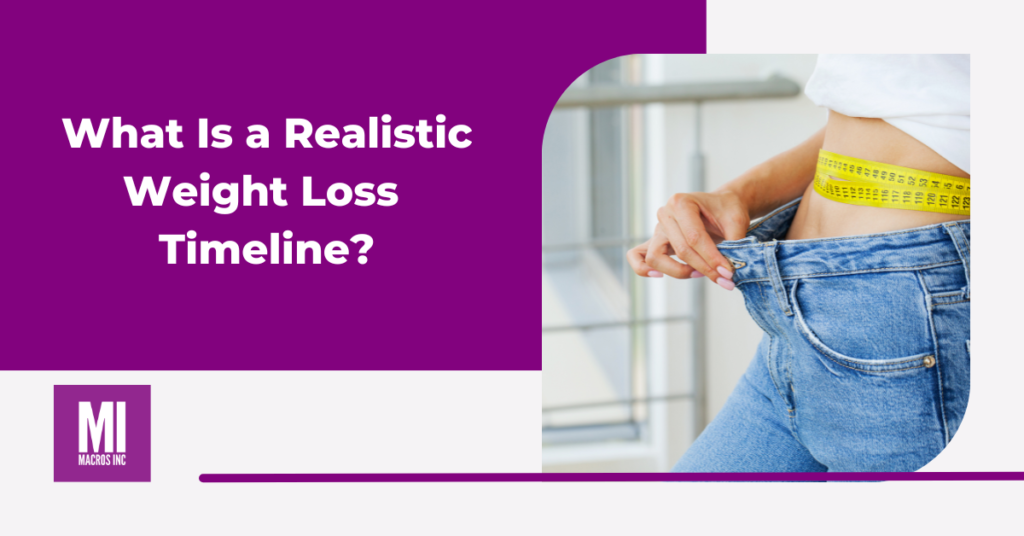It’s a bit daunting to try to figure out whether you’re making progress in a timely manner or not. How are you supposed to know if you’re doing well, going too slow, or even too fast? And, what is a realistic weight loss timeline? Here I’ll be talking about the different factors for how quickly you lose weight, and ultimately what a reasonable rate of progress looks like.
Jump to a Topic
What Is a Realistic Weight Loss Timeline?
The Basics
Before we talk about anything else, I first want to emphasize the main factor underlying all weight loss: Energy. Simply put, it’s a balancing act between the calories you consume and the calories you burn, also known as “Calories In = Calories Out” (CICO). This leads to three potential outcomes:
- If you eat more than your body needs, it stores the excess energy as bodyfat. (Fat gain)
- If you eat about enough to meet your body’s needs, fat is neither lost nor gained. (No change)
- If you eat less than your body needs, it will pull from your bodyfat to make up the difference. (Fat loss)
Granted, this is a simplified overview of what actually happens in your body. However, while the actual factors involved are more complex, it still comes down to calories in vs. calories out.
With that in place, let’s talk about the different things that determine how fast you lose weight.

Factors Influencing Weight Loss Rates
1. Weight Loss vs. Fat Loss
Unfortunately, the change on the scale isn’t completely indicative of the changes in your bodyfat levels. While many folks use “weight loss” and “fat loss” interchangeably, it’s important to understand that the two are not exactly the same. There are other things that make up your body besides fat, and they each contribute to your changing weight to a certain degree. I’ll touch on some of the more significant ones below.
2. Water
Water weight is a constantly fluctuating variable. The amount of stored water in your body changes quite a bit from hour to hour, let alone between days. You can test this rather easily – weigh yourself several times throughout the day, and see how your weight changes. It’s not uncommon to see a change of 5-10 pounds over the course of a single day. There are a few reasons for this, e.g. food in the gut, sodium, the menstrual cycle, etc.
When dieting, water tends to shed rather quickly at the beginning. As such, it’s common for the scale to drop several pounds in the first few days. The important thing to remember here is that this is water weight coming off, not bodyfat. As such, the rates of loss fall off quickly, and that weight will likely return when the diet ends. This isn’t necessarily a bad thing, but may dieters get excited at the initial rapid weight loss, only to be frustrated that they never see those rates again.
Finally, water is notorious for masking fat loss. This is one of the reasons as to why people see weight loss stall, despite them dieting properly. They’re losing fat, but retained water can keep the person’s net bodyweight the same. This is also a big part of why weight loss can happen sporadically instead of linearly. There’s a few factors at play as to why this happens, but regardless, it’s a very common occurrence.
3. Glycogen
Glycogen is the body’s way of storing carbohydrate. It is found in your liver and muscle tissues. It serves the purpose of providing stores of quick energy for the body. We have glycogen because of how easily our body can turn it into glucose for energy. By contrast, bodyfat can store much more energy, but the body breaks down those stores much slower.
Since glycogen is another stored source of energy, its levels will start to deplete over the course of a sustained calorie deficit. This will be reflected in a drop on the scale. Glycogen also contains a lot of water, which further increases the weight lost when it’s used up.
As with water, glycogen can be replenished upon leaving a calorie deficit, so it also contributes to a bump in the scale after the diet ends.
4. Lean Body Mass
Lean body mass refers to anything in the body that isn’t made of fat. This includes things like glycogen, water, organs, bones, and muscle. We’ve covered water and glycogen already, but let’s talk about the other three.
As far as organs and bones go, there shouldn’t be much change, if at all. Or at least I certainly hope there isn’t. Cutting off a limb is definitely a way to lose weight, but I can’t say I recommend it.
This leaves muscle. It is certainly possible to lose muscle in a calorie deficit. When dieting, the body effectively breaks down things that it determines it doesn’t need, instead prioritizing the most important functions for life. Therefore, it uses the lost muscle as an additional source of energy and amino acids to sustain itself.
Since most people are looking to lose fat, and not their gains, it’s usually in best interest to minimize muscle loss as much as possible. The two biggest factors in retaining muscle are going to be adequate protein intake and resistance training. The protein ensures your body has enough amino acids to satisfy its needs. Resistance training keeps your muscle active, and thus makes it more of a conservation priority for your body.
5. Activity Levels
This is related to CICO and the body’s energetic needs. The body’s energy requirements can be separated into two different categories: Maintenance and activity. Maintenance is the energy needed for the body to keep you functional and healthy, e.g. repairing tissues, organ function, breaking down food, etc. Activity refers to the energy your muscles need to move your body. We’ll be talking about the latter here.
Simply put, the more you move around, the more calories you burn. However, this isn’t necessarily talking about cardio or working out. While those do indeed burn calories, it’s actually lifestyle habits that tend to make the biggest difference. This makes sense – exercising is usually only one to two hours of your day, while your activities comprise the other 22-23. This is why people who have very active jobs tend to have much higher calorie requirements than those with sedentary ones, e.g. a construction worker vs. a computer programmer.
6. Size of Deficit
This also relates to CICO. The less energy you take in, the more your body will have to pull from its bodyfat stores to compensate. On paper, this sounds great – the faster you finish the diet, the better, right?
Well, not quite. Larger deficits can lead to faster fat loss, but they also come with more considerations. The less you eat, the harder it tends to be to deal with the hunger, as you’re generally getting less food. This also tends to affect energy levels, leaving people more sluggish, with impaired performances in the gym, etc.
Steeper deficits also carry a somewhat higher risk for muscle loss. This can be somewhat offset with increased protein intake and a suitable resistance training routine, but the low calories and decreased energy can make both more difficult.
Finally, the increased fat loss is not linear. For example, if you double your deficit from 500 to 1000 calories, you aren’t necessarily going to lose fat twice as fast. This is due to a combination of metabolic factors as well as the above factors.
Overall, increasing one’s deficit is certainly possible, but whether it’s worth it depends on the circumstances at hand.
7. Leanness
This one partially explains why dieting tends to become harder as you go. In general, the leaner you are, the slower fat loss tends to be, and the harder you have to work to achieve it. A lot of this is going to be dependent on the person in question, but this sliding scale is true for everyone.
This can be illustrated by contrasting two different ends of the spectrum. A person who has hundreds of pounds of fat to lose can make very small changes to their diet and activity levels, and start to see dozens of pounds fall off quickly. At the other end, a competitive bodybuilder dieting for a competition have to physically push themselves to the limit, follow a very restrictive diet, and count calories religiously to drop their last 5 pounds.
In practice, most people won’t be anywhere near these two extremes, but the same principles still apply across the board.
Recommendations
After all of that, I’d be amiss if I didn’t actually recommend some sort of weight loss rate to aim for. In general, a reasonable goal is about 2-8% of your bodyweight per month, or 0.5-2% per week. I recommend using monthly rates over weekly, as the latter tends to fluctuate significantly due to water weight changes.
So, for a 150 pound person, that would be about 3-12 pounds over a given month, or about 0.75-3 pounds per week. People on the leaner side would likely fall on the lower end of that progression scheme, while those with more to lose would be somewhat higher.
Conclusion
Above all, remember that dieting should be something sustainable, and as relatively painless as possible. There are few things more frustrating than trying to rush progress to meet a goal by a certain date. Instead, figure out how much you’d like to lose, and then use the above rate to construct a reasonable timeline for your efforts. The more time and grace you give yourself for a goal, the better off you’re likely to be.
Try our nutrition coaching, for free!
Be the next success story. Over 30,000 have trusted Macros Inc to transform their health.
Simply fill out the form below to start your 14-day risk-free journey. Let's achieve your goals together!

